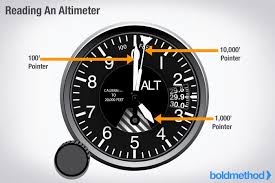We are going to have a quick look at air pressure, and why it is important for pilots to understand it.
Certain instruments in the cockpit are driven by or measure air pressure, the obvious one in the altimeter, this instrument measures the “static” pressure or barometric pressure to determine the height of the aircraft. we will cover the details of how this works on another lesson, but for now we just need to point out that we set the pressure reading for the altimeter using the small pressure dial (barometric altitude).

Now we just need to cover a few facts and terms that we will be using in the rest of this lesson:
- Air pressure is measures in millibars or hectopascals, they both have the same units so 990mb is the same as 990Hpa
- Pressure drops by 1mb for every 30 feet in altitude.
- Standard Pressure –
- ISA Temperature,
- QFE – The barometric altimeter setting that will cause an altimeter to read zero when at the reference datum of a particular airfield (in general, a runway threshold). In ISA temperature conditions the altimeter will read height above the datum in the vicinity of the airfield.
- QNH – The barometric altimeter setting that will cause the altimeter to read airfield elevation when on the airfield. In ISA temperature conditions the altimeter will read altitude above mean sea level in the vicinity of the airfield
What is air pressure:
Atmospheric pressure is the force per unit area exerted on a surface by the weight of air above that surface in the atmosphere of Earth – basically it is the weight of the air above you.
